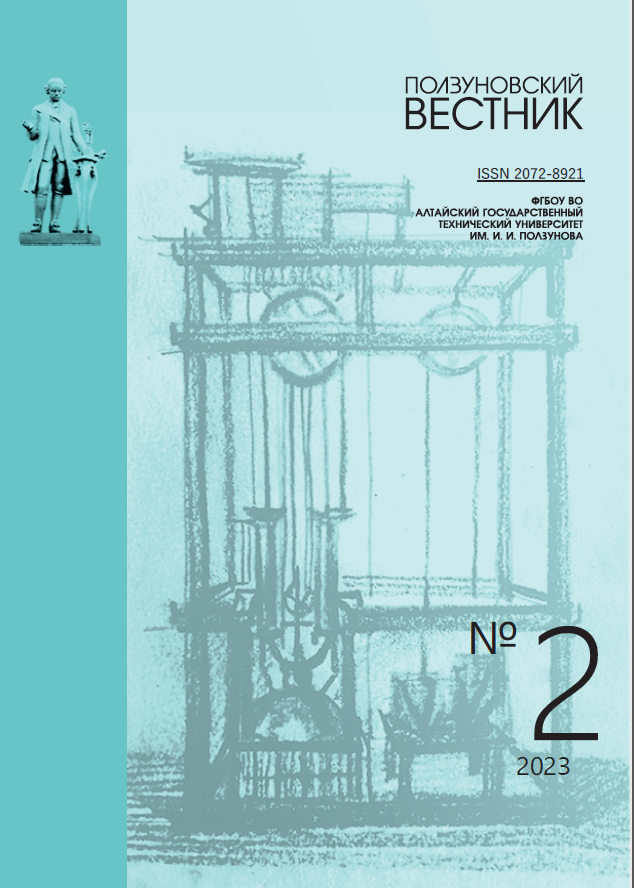INFLUENCE OF ONE-WALL CARBON NANOTUBES ON THE ELASTIC-STRENGTH PROPERTIES OF EPOXY BINDING
AOIQRT
DOI:
https://doi.org/10.25712/ASTU.2072-8921.2023.02.026Keywords:
epoxy binder, carbon nanotubes, modification, tensile strength, modulus of elasticity, impact strength, binder, SEM, destruction, ultrasound, suspensionAbstract
The article reflects the results of studies on influence of carbon nano tubes (CNT) on the elastic- strength properties of epoxy resin. Electronic-microscopic researches show the change of supramolecular structure with formation of well-organized structures at introduction carbon nano particles in epoxy binder on the basis of epoxy resin of ED-20 and isomethyl - tetrahydrohthalic anhydride (iso-MTGFA) was chosen as a hardening agent. Possibility and effectiveness of use of ultrasonic dispersion of superconcentrate on basis of CNT in the composition of resin was analysed. Research of influence of CNT concentration from 0 to 0,5 mass% in the composition of epoxy resin on the tensile strength and module of elasticity at tension and compression, Charpy impact strength is carried out. It was established that when introducing CNT into the composition of epoxy resin changes of elastic- strength properties are onserved. It was experimentally determined that modification by means of superconcentrate on basis of CNT results in increase of tensile strength and module of elasticity at tension and compression, Charpy impact strength. At CNT concentration in the epoxy resin composition from 0,25 mass% to 0,5 mass% increase of tensile strength at tension on 32% and module of elasticity at compression on 10 % is observed.
References
Iartsev V.P., Podolsk М.А. (2014). Composites on the basis of polyester resin with polymeric additions. Announcer TGТU (3) pp.557-563. (In Russ.).
Sokolenko I.V. (2014). Perspective fillers for the polyester composites. The International scientific research 2–4, pp. 92–93. (In Russ.).
Vigdorovich V.I. (2013). Carbon nano-materials and composites on their basis. Announcer of the Tambov university. Series: Natural and tech-nical sciences 4. pp. 1220–1228. (In Russ.).
Vereshagin А.L. (2001). Ultrafine diamonds of detonation synthesis. Biisk: Pub. of Altaj State Technical University. pp. 177. (In Russ.).
Putilov А.V. (2002). Nanomaterials and nanotechnologies are a breach in the future. Engi-neer-chemical science for advanced technologies. М. : Science, pp. 284. (In Russ.).
Marakhovsky P.S., Kondrashev S.V., Akatenkov R.V., Aleksashin V.M. and others (2015). On the modification of heat-resistant epoxy binders with carbon nanotubes. Bulletin of the Moscow State Technical University named after N.E. Bauman. (2), p. 118–127 (In Russ.).
Domun N., Hadavinia H., Zhang T., Sains-bury T., Liaghata G.H. & Vahida S. (2015). Improving the fracture toughness and the strength of epoxy using nanomaterials – a review of the current status. Nanoscale, (7), p.10294–10329.
Inam F. and Luhyna N. Carbon Nanotubes for Epoxy Nanocomposites. A Review on Recent Developments.In proceeding of 2nd International Conference on Advanced Composite Materials and Technologies for Aerospace Applications. Wrexham, UK, 2012. p. 80–86.
Moosa A.A., Ramazani A.S.A., Ibrahim M.N. (2015). Effects of Carbon-Nanotubes on the Me-chanical and Electrical Properties of Epoxy Nano-composites. International Journal of Current Engi-neering and Technology, (5), р. 3253.
Muhammad Ismail A.H., Risby M.S., Ali A., Sapuan S.M. & Hoque M.E. (2015). Flex-ural strength and fracture toughness of carbon Nano-tubes (CNTs) reinforced epoxy composites. In Pro-ceedings of Seventh The IIER International Confer-ence. Singapore. р. 44–48.
Mohamed I., Saleh N.J., Mohmoud L.H. (2015). Studying the Mechanical Properties of Epoxy Carbon Nanotubes Composite. College of Engineer-ing Journal (NUCEJ), (1), p. 84–90
Downloads
Published
How to Cite
Issue
Section
License
Copyright (c) 2023 Aisen Kychkin, Anatoliy K. Kychkin, Aleksei G. Tuisov, Mikhail P. Lebedev, Elena S. Anan'eva

This work is licensed under a Creative Commons Attribution 4.0 International License.















 .
. This work is licensed under a
This work is licensed under a 
